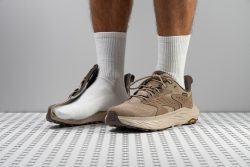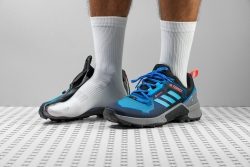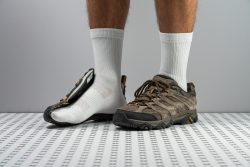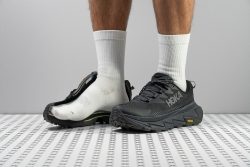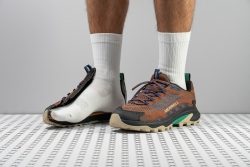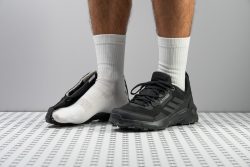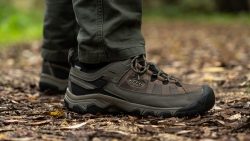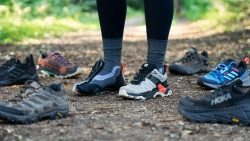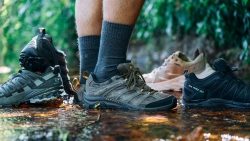7 Best Hiking Shoes in 2025
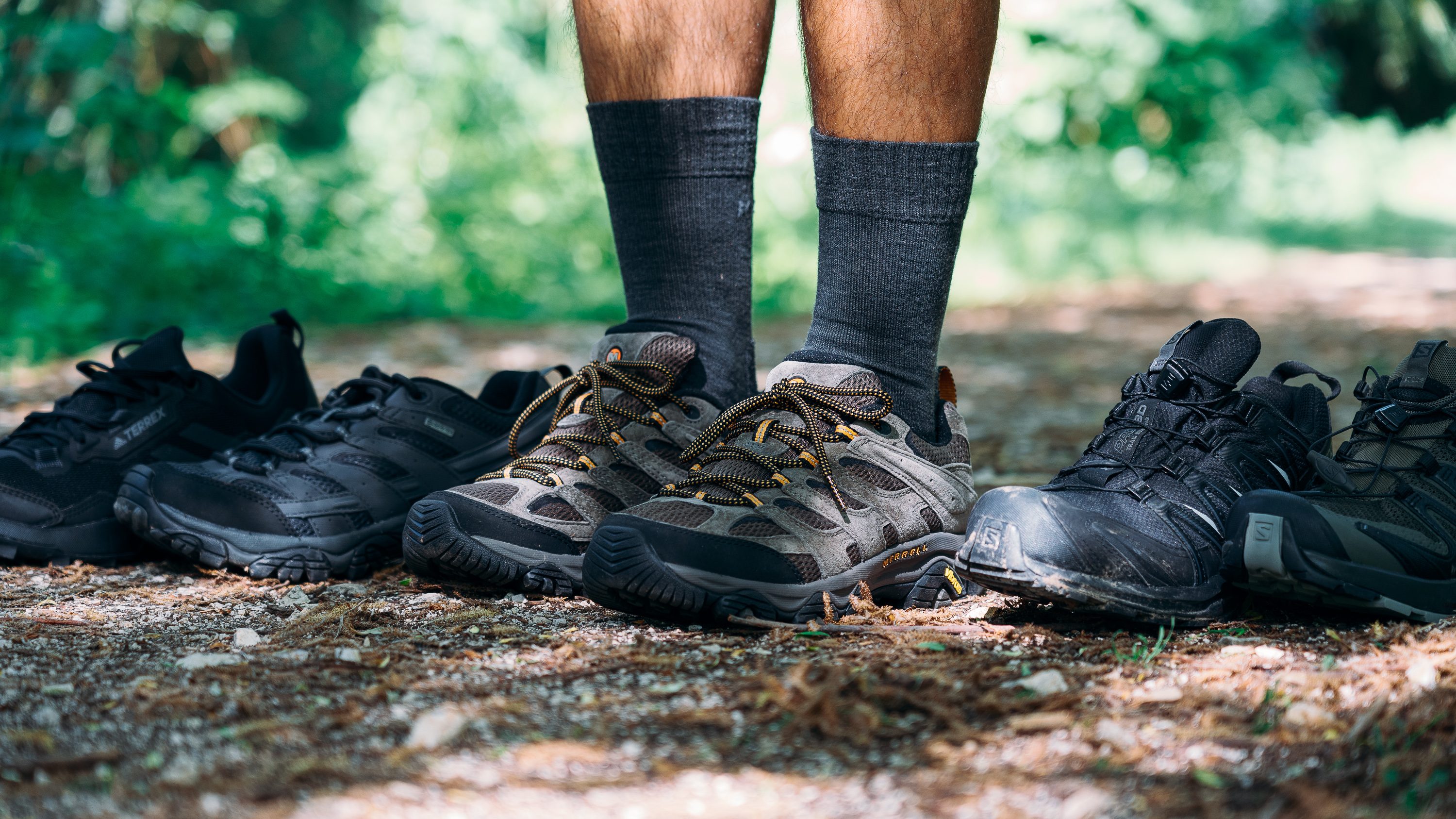
We buy shoes ourselves. We earn commissions when you buy through us, at no extra cost. Why trust us
When it comes to getting the right footgear for hiking, many are still at a loss. But don’t fret. Choosing the right pair need not be a nightmare, thanks to our best hiking shoes list and our handy buyer’s guide.
We have tested many hiking shoes to single out the best options. Whether you are after a light, urban pair or something a bit more rugged for a multi-day hike, we’ve got our top picks in different categories.
To learn about the nuances of hiking shoes, why toebox durability matters, or how stiffness affects support and stability, check out our guide.
How we test hiking shoes
At RunRepeat want to make sure you get the most up-to-date and honest reviews on the best hiking shoe options out there. Here is our approach:
- We buy shoes ourselves: As an independent review website, we avoid sponsorships and purchase all hiking shoes with our own money to stay unbiased.
- We test in real conditions: We take each shoe on a series of hikes on various distances and terrains to check every important aspect, including durability, comfort, waterproofness, and more.
- We go extra hard on popular shoes: We are especially wary of the most sought-after models, so we put them through our rigorous lab tests. 'Rigorous' to the point that we also slice the shoes open!
Best hiking shoes overall
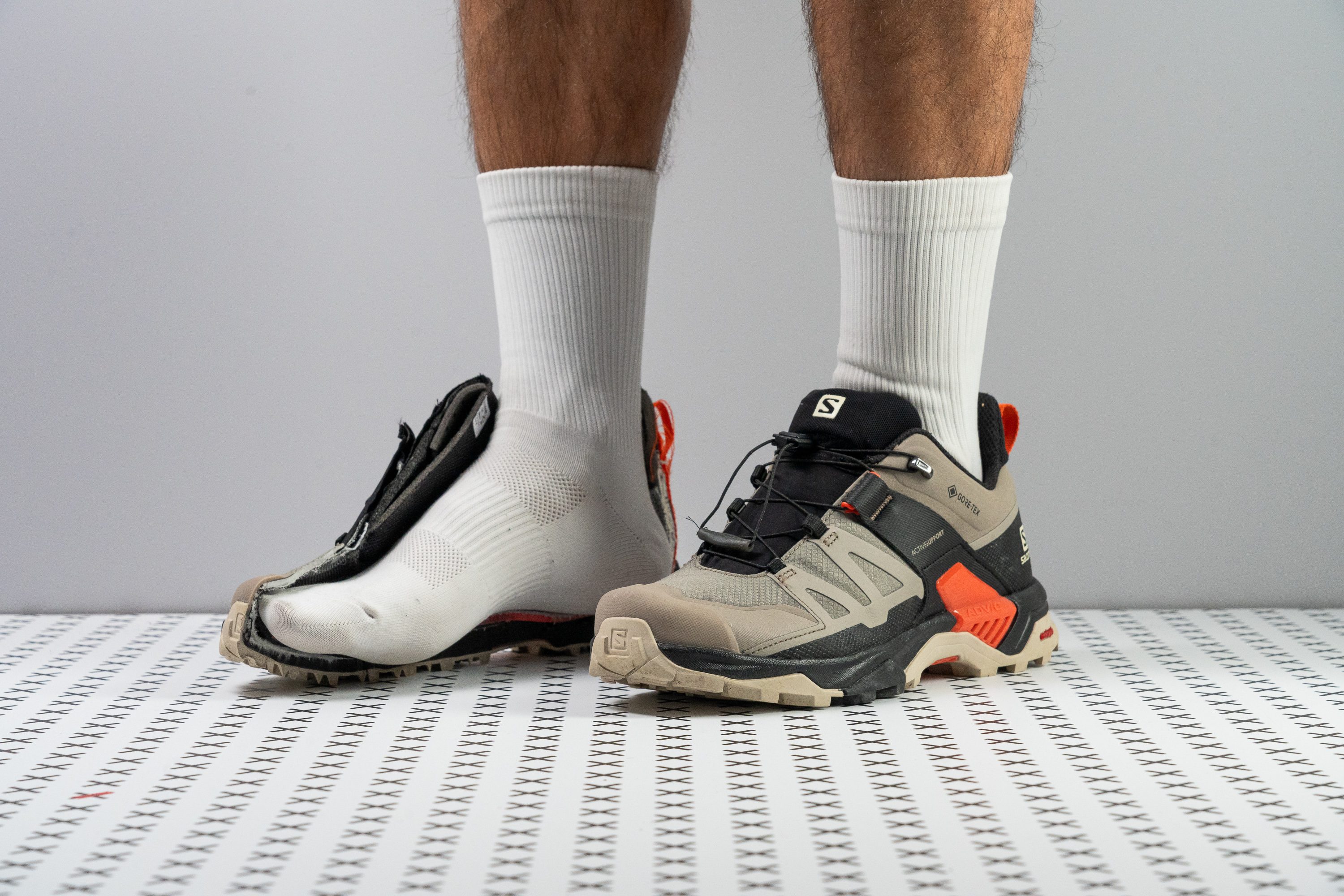





































What makes it the best?
Whether we want a comfortably cushioned shoe for long days, a sticky shoe for technical terrain, or something waterproof for wet days, there is one shoe that can do it all. The Salomon X Ultra 4 GTX is perfectly cushioned, grippy, and impeccably waterproof, all wrapped into a lightweight package.
Our feet felt in equal parts cushioned and protected in the X Ultra 4 GTX. We measured the softness of the midsole in the lab with a durometer, and all became clear. With a midsole measuring 32.5 HA, it hovers around the average for hiking shoes, blending protection with ground feel in a harmonious balance.
We felt confident in the shoe’s grip on all terrain from soft and muddy trails to loose gravel and rocks. The 4.5 mm lugs are indeed a little deeper than the average 4.3 mm, but the Contragrip sole has an extra trick or two up its sleeve. The chevron patterning favoured by Salomon makes light work of steep inclines and the chunky heel lug offers excellent stopping power on the descents.
Venturing out in the rain isn’t a problem in the Salomon X Ultra 4. Its perfectly executed waterproofed membrane kept our feet dry during shallow stream crossings and splashing through puddles, all without weighing us down. In the lab, we popped the shoe on the scales, where it weighed in at 13.3 oz (378g), 0.6 oz (17g) below the average for waterproof hiking shoes. We felt able to hike further and for longer before our feet got tired.
Whilst at room temperature this is a flexible shoe, on a cold winter’s day it’s another story. We left it in the freezer for 20 minutes before testing it for flexibility. It stiffened up by 75%, compared to the average of 49%, so definitely needs some breaking in to be comfortable when it’s cold out. We therefore don’t recommend this shoe to hikers who need a flexible hiking shoe in the cold season.
Pros
- Instant comfort
- Impeccable waterproofing
- Very lightweight
- Exceptional grip
- Excellent support and lockdown
- Stable platform
- Roomy toebox
Cons
- Quicklace is not for everyone
- Too-high collar
Hiking shoes with the best cushioning
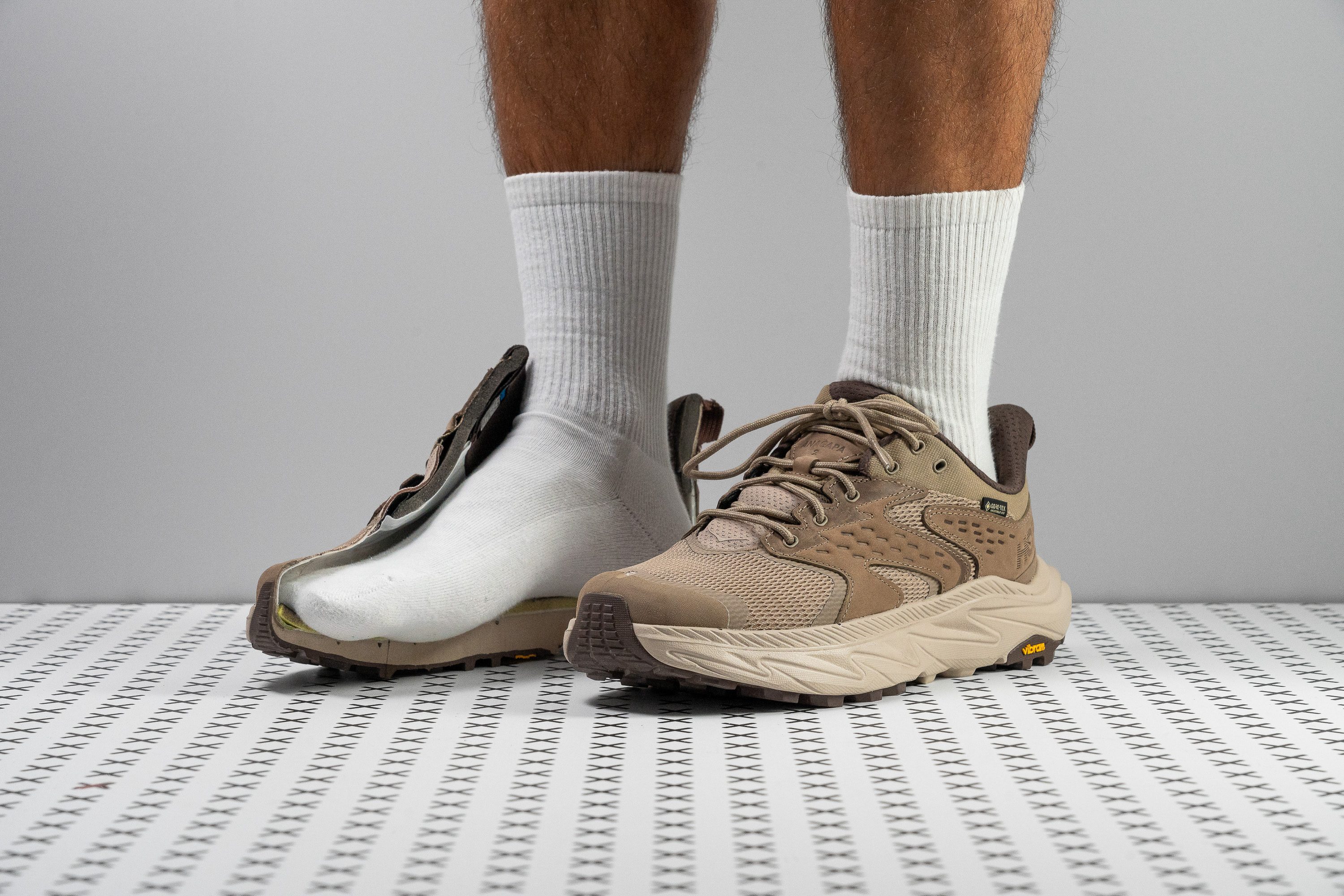























































What makes it the best?
Our hikes felt comfortable all the way with the Hoka Anacapa 2 Low GTX beneath our feet. This plush cruiser offers the best cushioning among hiking shoes we analysed in the lab, coupled with a confidently steady and grippy ride to keep us safe across mixed terrains.
The Anacapa 2 Low GTX packs much foam between our feet and the ground, isolating us from sharp rocks and roots that we encounter. Our calliper shows above-average measurements of 36.0/24.0 mm in the heel and forefoot, keeping us cosy even during multi-hour adventures.
We had no worries about rolling our ankles or spilling over because the shoe’s massive platform and sturdy sidewalls gave a well-planted feeling. Our readings show its base is 7.2/4.7 mm wider than the average hiking shoe. Additionally, its high level of torsional rigidity delivers excellent lateral support, backed up by its 4/5 score in our manual twist assessment.
The outsole features the reliable Vibram compound, ensuring protection from wear. It includes badass 5-mm lugs that grip all terrains effectively, ensuring we can fully enjoy the trails without slipping.
However, we cannot recommend this pair to people who hike in warmer climates because of its Gore-Tex upper. Those who prioritise breathability should opt for a non-GTX shoe.
Pros
- Fantastic balanced cushioning for long hikes
- Excellent protection from impact, rocks, and trail debris
- Excepitional side-to-side containment and wide platform
- Perfect grip on various terrain
- Durable Vibram rubber
- Effective but lighter-feeling Gore-Tex waterproofing
- High-quality nubuck panels
- True to size
Cons
- Upper mesh is not very durable
- Loses midsole softness in cold
Hiking shoes with the best stability
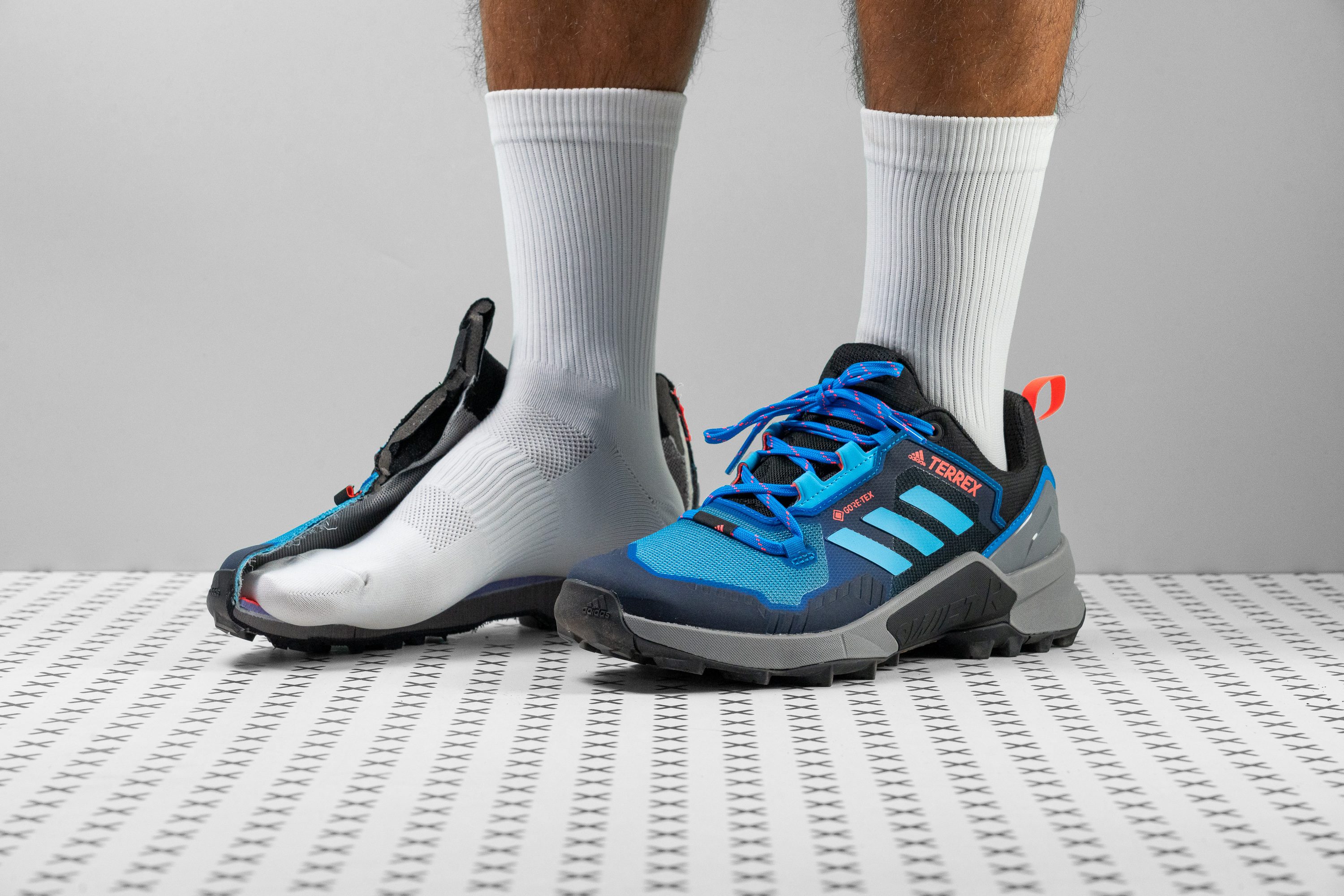












































What makes it the best?
Adidas Terrex Swift R3 GTX is a hiking shoe that feels as stable as a hiking boot. Not only that, but we love the overall secure feel it offers, thanks to the badass grip and stiff midsole. No wonder we found it to have the best stability in the world of hiking shoes!
We took this shoe to multiple hikes and tested it in the lab. After all that, figuring out why it's so stable was a piece of cake. First, when doing the lateral stability test, we did not even notice that it had a low cut! It felt more like a hiking boot.
Second, when we tried to twist it, we realised it was almost impossible to do that. So much resistance! On this test for torsional rigidity, we gave the shoe 5/5, where 5 is the stiffest. What also contributed to this secure feel was a heel counter: with a rating of 4/5 for stiffness, it meant no joke. It hugs the back of the feet and allows for no unwanted movement!
Worry not, just because it scored the highest on the torsional rigidity test, it does not mean that the ride feels unnatural. When we pushed the shoe to 90 degrees using a force gauge, we learned that it is actually just around the average (it scored 34.1N, the average is 36.4N) when it comes to longitudinal flexibility. This makes the feel of the ride, environment, and overall foot movements not restricted.
Third, the Pro-Moderator technology, that we found to be embedded into the sole on both sides, turns out to be an awesome foot stabiliser. With such a compact and secure foothold, we felt much less fatigue at the end of each hike.
Keep in mind that, because of the Gore-Tex membrane, this shoe is too hot for summer days.
Pros
- Boot-like stability
- Highly durable and protective
- Lightweight for what it offers
- Excellent waterproofing
- Breathable for a GTX shoe
- Generously cushioned
- Very secure foothold
- Top-notch grip with deep lugs
Cons
- Stuffy for summer
- Can be too stiff (even stiffer in cold)
- Break-in needed
Hiking shoes with the best comfort
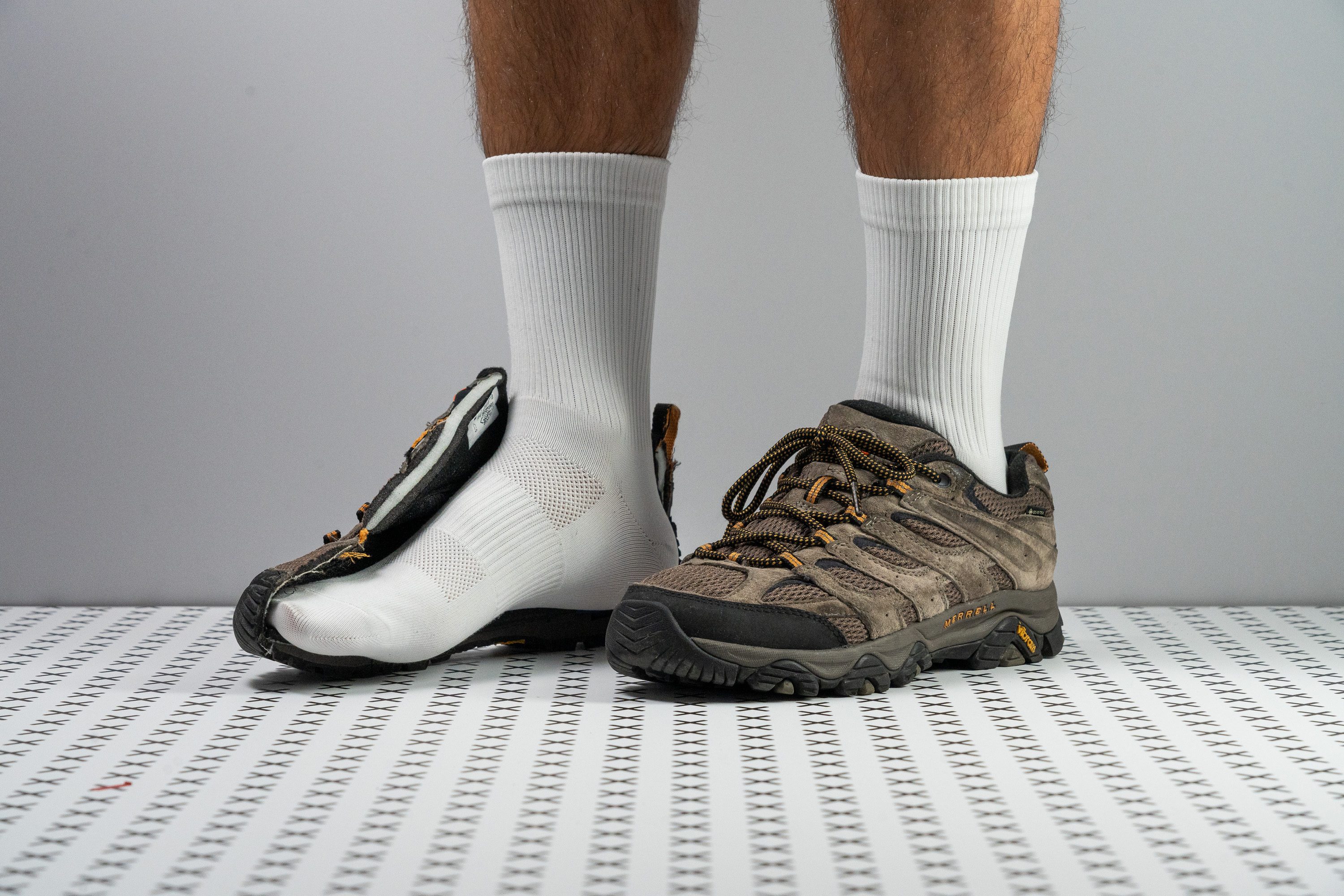
































What makes it the best?
It takes a lot to be crowned as the most comfortable hiking shoe and this shoe delivers just that: a lot. It's cushioned, padded, flexible - all wrapped up in a day-one comfort package. Its grip is out of this world and there are many details, like a gusseted tongue and very padded tongue, that seriously up the ante when it comes to overall comfort.
We've took the Moab 3 GTX to the trails and we've cut it in half in the lab. Being able to see and measure all the bits and pieces allowed us to understand why this shoe rocks at comfort. First, its cushioning. While on the firmer side, it does not feel like a brick. It feels perfectly balanced - not too firm and not too squishy. In the lab, we pressed our durometer against the midsole and recorded 35.9 HA. That's 14% more (and therefore firmer) than the average.
Second, the grip is 10/10. The outsole is 2.3 mm thick (just like the average for hiking shoes) and the lugs are 0.5 mm thicker than the average ones. Our calliper measured them to be 4.8 mm deep. Whatever we threw at them - rocks, snow, mud, gravel - they handled like pros.
The tongue is perfectly gusseted and allows nothing to get inside of the shoe on the sides of the tongue. For the rest, we have a Gore-Tex membrane to do the same job and it does it wonderfully. Our feet were dry at the end of a 20+ mile hike where rainy clouds kept following us for some reason. The best thing, though, about the tongue is its thickness. At 14.6 mm, it's 3.2 mm thicker than the average. It perfectly cushions the instep and it's the reason why we never felt any lace bites. We did tighten the laces a lot!
The Gore-Tex membrane keeps the water out. But it also keeps the air from circulating. This is why we don't recommend this shoe to hikers who regularly hike in warm climates.
Pros
- Superb day-one comfort
- Brilliant surface adhesion
- Supportive like a work shoe
- Fantastic cushioning underfoot
- Remarkably durable
- A-grade waterproofing
- Sheds mud quite well
- Protective toe box
- Incredible overall quality
Cons
- Heavy for a low-top
- Subpar breathability
- Its shoelaces unravel often
Best hiking shoes for summer
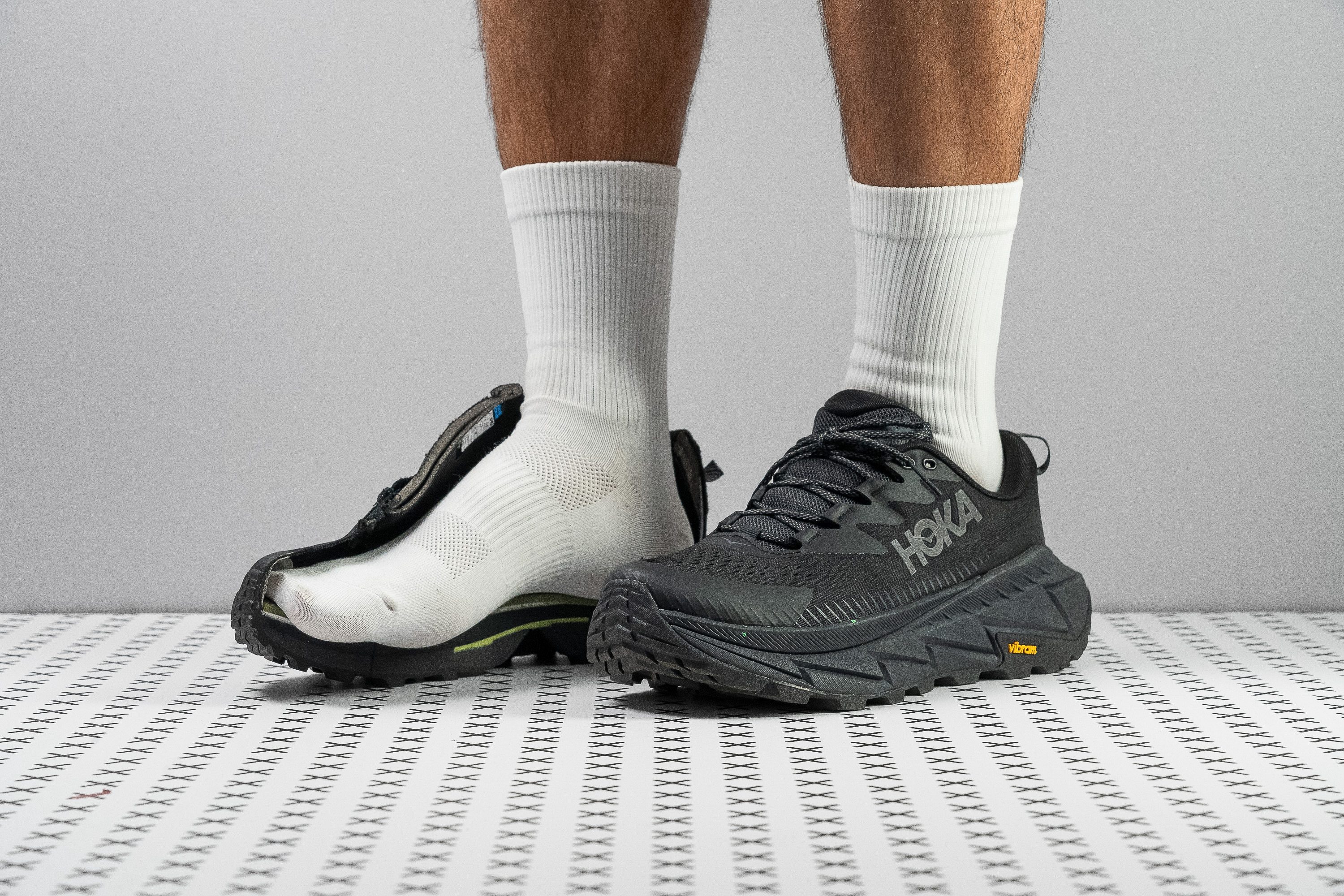















































What makes it the best?
Hoka’s Skyline-Float X couldn’t be more perfectly named as we felt like floating through the trails with its sky-high and cloud-like stack, airy upper, and excellent multi-terrain traction. It’s our top summer hiking shoe that handles all distances and paces well with its responsive yet stable ride, as proven by our lab.
The upper feels padded yet surprisingly breezy since it has many ventilation holes. Our lab confirms it’s a fine choice for warm weather and all-day hikes with a 5/5 breathability score.
Each stride feels pampered with plush and bouncy cushioning. Our calliper confirms a mega 39.0/21.0 mm stack, erasing ground feel almost entirely. Surprisingly, the ride feels stable due to the stiff Pebax plate, broad base, midsole sidewalls, and dual-foam setup. The top layer is a plush 22.0 HA, compressing delicately underfoot and springing us off in a lively manner. While the bottom layer is a balanced 27.9 HA to boost our surefootedness.
Further enhancing our control on tricky terrain is the ever-reliable Vibram outsole. With 3.7 mm lugs, it bites into soft ground and sticks well even on wet rocks. We had no slips no matter where we hiked.
Unfortunately, the Skyline-Float X missed the weight department. At a bulky 14.5 oz (410g), it’s 7.3% heavier than the average hiking shoe.
Pros
- Extremely well-cushioned
- Devilishly comfortable
- Responsive, rockered midsole
- Works for light trail running
- Excellent multi-terrain traction
- Highly breathable upper
- Feels surprisingly stable
- Performs consistently in the cold
- Made of sustainable and plant-based materials
Cons
- Questionable durability
- Narrow toebox
- Upper dries slowly
Best lightweight hiking shoes
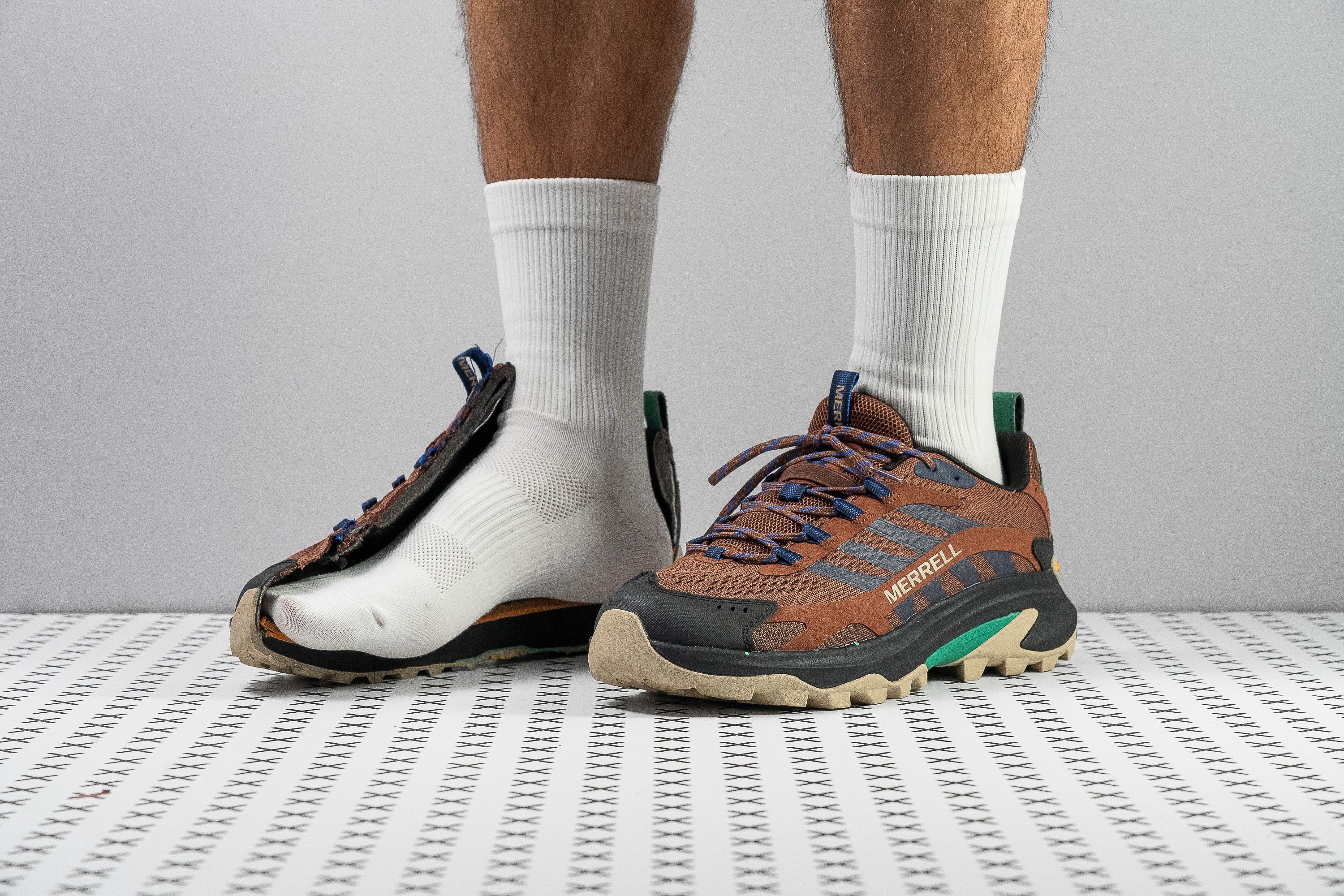





















































What makes it the best?
On our test hikes with the Merrell Moab Speed 2, we already knew it was a contender for the best lightweight hiking shoe, and our lab further confirms it with a mere 11.6 oz (329g) build vs. the 13.4 oz (379g) average! Despite the 13.4% difference, this shoe blew us away with generous cushioning, solid footing, and top-tier durability.
Less weight usually means less cushioning, yet Moab Speed 2 defies the standard with a whopping 38.8 mm heel, 7.4 mm above average! All-day hikes felt effortless as the plush cushioning delivered lasting comfort. Our durometer confirms a low 19.0 HA reading, 31.4% softer than average.
While the foam is lighter than average, it is by no means unsteady because of the FlexPlate. This adds stiffness underfoot for a more controlled and stable experience, thereby preventing the early onset of fatigue. Our manual assessment confirms it’s hard to twist, earning a 5/5 torsional rigidity score.
Moab Speed 2’s all-around robust nature impressed us. Our Dremel was no match against the sturdy overlays in the upper and Vibram TC5+ outsole, earning 5/5 toebox durability and showing 20.0% less damage vs. average in the outsole.
However, we recommend limiting the use of this shoe to off-road surfaces and trails to preserve its life. The toothy 3.7 mm lugs tend to wear faster out in concrete and asphalt.
Pros
- One of the lightest hiking shoes
- Plush and abundant cushioning
- Great support and stability
- Perfect grip for moderate terrain
- Excellent durability
- Breathable for summer
- Cosy step-in feel
- Two loops for easy on-off
Cons
- Frail inner lining
- Small debris gets inside
Best budget hiking shoes
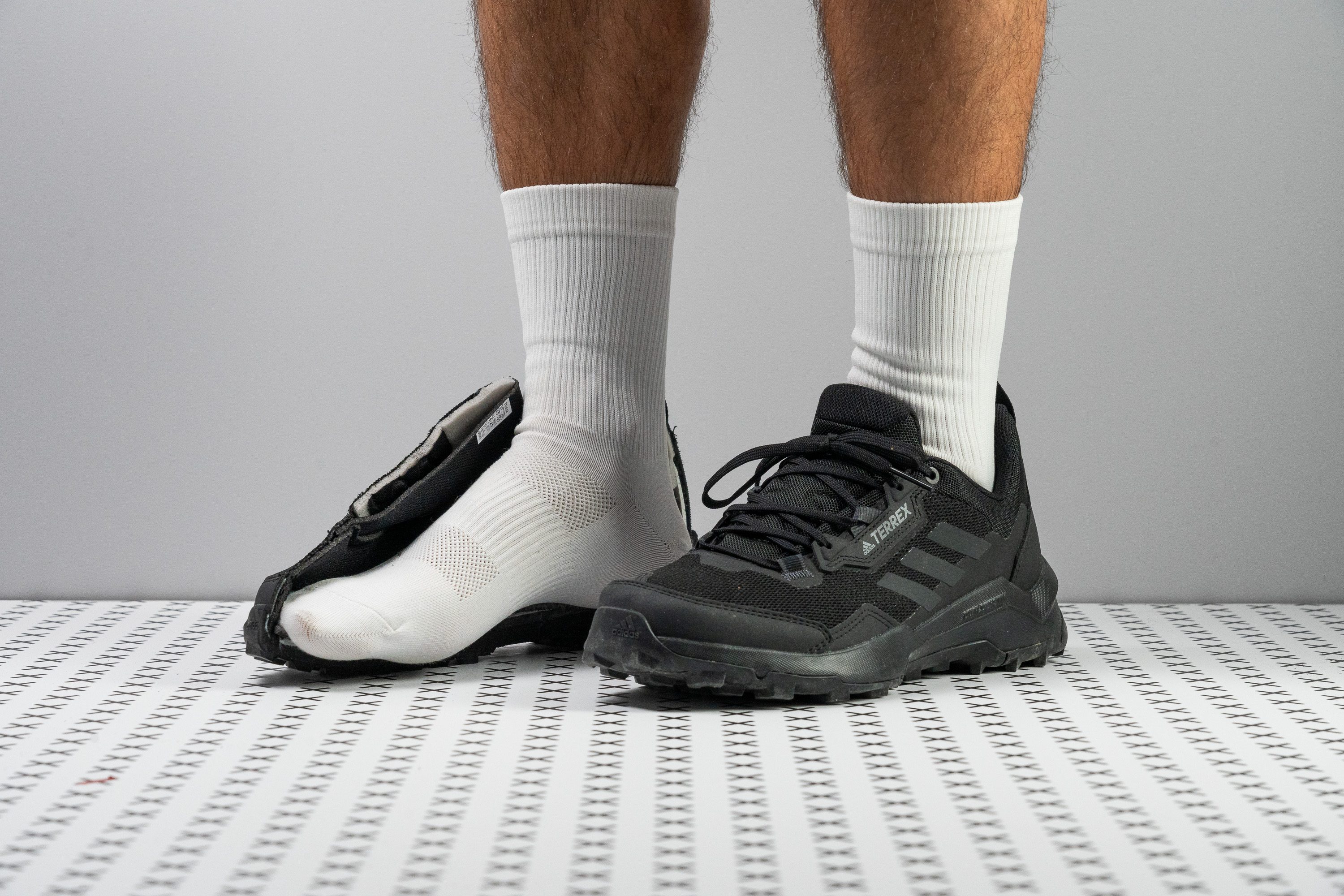






























What makes it the best?
Terrex AX4 retails at only £90! In all its glory and that means we enjoyed its grip, ground feel and stability. Add to that that it's 30% cheaper than the average hiking shoe (£130) and you know why we had to pick it as the best budget hiking shoe!
Immediately upon getting the shoes, we realised how simple they are. Make no mistake, this had nothing to do with the comfort that the AX4 delivers. We had no fatigue even after very long hikes! We blame good cushioning for this and stack heights that are just around the average. After cutting the shoe in half, we used a calliper to measure the stack heights, the heel sits at 30.6 mm, while the forefoot sits at 20.9 mm.
Back to cushioning: we used a durometer to assess its softness and learned that it's actually 11% firmer than the average. We can't say we experienced any discomfort but we did appreciate the stable feel. Shoe's platform, that's wider than average, contributed to that as well.
In our hiking tests, we took the Terrex AX4 to a speed hiking session and a few hikes, mostly in wet weather. 3.7-mm-deep lugs made sure we slipped 0 times!
Be warned, though, that the insole is very thin: 2.6 mm! The average insole in hiking shoes is 4.9 mm thick. We understand that for a hiking shoe to weigh 379g or 13.4 oz there had to be cuts but keep in mind that you might want to swap this one with a more cushioned insole.
Pros
- Excellent value for money
- Feels like a trail running shoe
- Breathable
- Water-repellent
- Solid grip
- Durable for the price
- Stable platform
- Contains recycled materials
Cons
- Lacks toe protection
- Flimsy insole
- Aggressively tapered toebox
Do you actually need hiking shoes?
Generally, common hiking shoes offer more protection, traction, and stability than trail runners and trainers. We have wear-tested and lab-tested all of these and can confidently guide you towards the right choice.
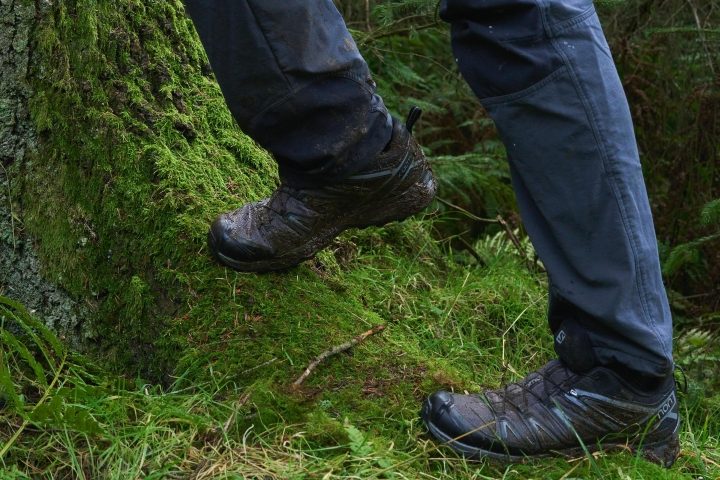
When you might get away with your running shoes:
- You’re the athletic type and know your way around spending time outdoors.
- You plan to do easy hikes: short, on rather even terrain, with no technical sections (sharp rocks, debris). Hard-packed and well-maintained trails can be covered in running shoes.
If, however, you plan to get into hiking for real and do frequent hikes, longer hikes, especially the ones with heavy backpacks and demanding terrain, then a sturdy, supportive, and grippy pair of hikers is what you need.
We’ve inspected hiking footwear inside out - in the lab and out on the trails. What matters in hiking is:
- Type of the terrain (hard ground or soft ground; hard-packed or loose)
- Season (do you need waterproof features? Is there any slush, mud, snow?)
- Weight of your backpack (backpacking asks for more stability and support)
- Length of the hike (easy and short hikes can be done in shoes meant for hiking fast and light, while longer hikes, especially multi-day ones, ask for support and stability).
We’ve combined these into the most frequent combinations. Here’s how we’d go about finding the right pair.
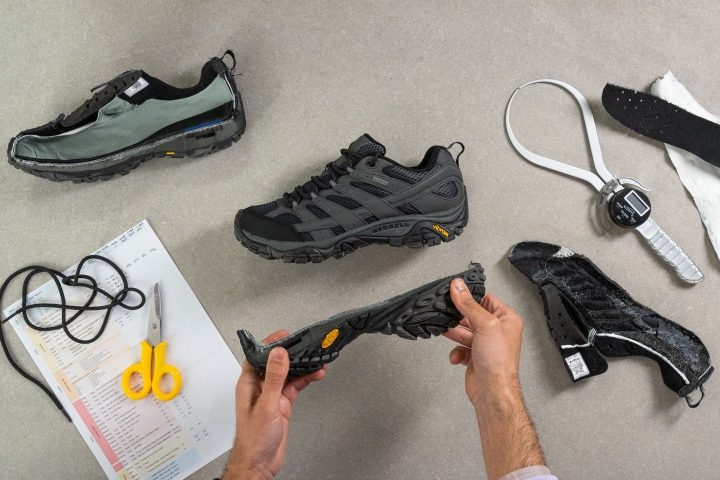
When to get an all-around day hiking shoe
You plan to do hikes that are rather easy and short. No technical terrain, scrambling, no heavy rain and snow.
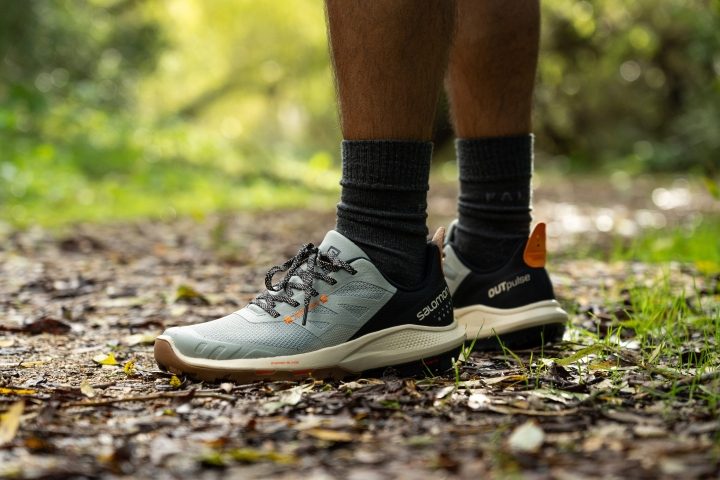
We suggest getting a workhorse of a hiking shoe that will work in most cases but won’t excel at one thing specifically.
Features to look for:
- Lighter weight, around 14.1 oz (400g) or less
- Average-to-high breathability, which means shoes that scored 3, 4, or 5/5 on our breathability lab test*
- Average-to-high flexibility because they allow for more natural foot movement. Stiffer shoes are better for technical terrain when you need extra stability. We measure the flexibility of every shoe and compare it to the average in the review.
- Average lug depth (4 mm). We say average because the smallest lugs might not have enough grip and are best used in hybrid situations (covering both road and trails) and because very deep lugs will wear out soon and are best used on soft ground only.
*In case you do plan to hike in wet weather, check out our list of waterproof hiking shoes we’ve tested so far. We dive into details on waterproofing further down.
Keep in mind that, by default, these shoes are less breathable. The waterproof membrane does not breathe well.
Fast and light hikes ask for the lightest shoes
You want to cover as much ground as possible in little time. You want to move fast and light. Some brands even have an apparel category called FL (fast and light).
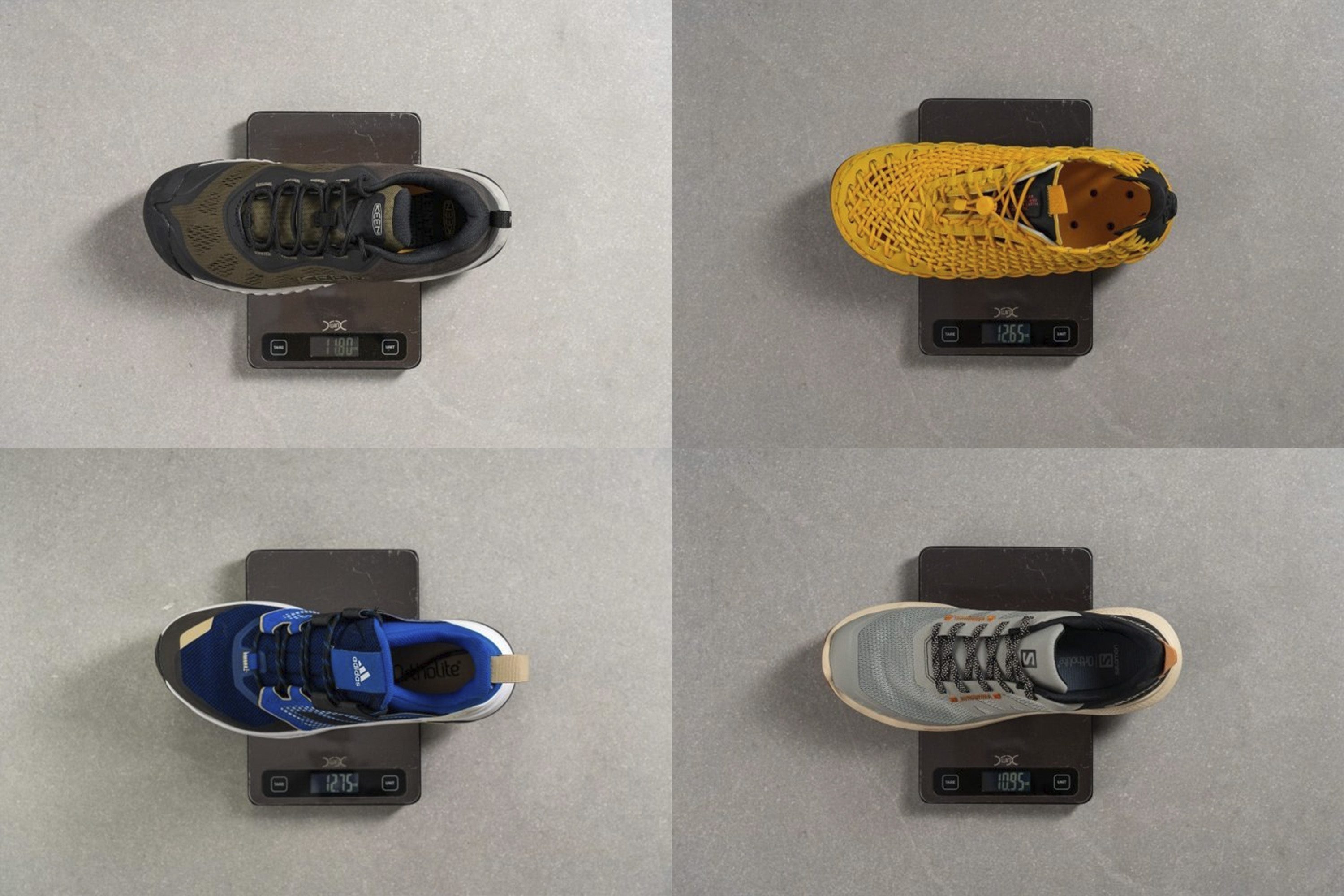
In this case, we suggest getting the lightest hiking shoes out there:
These shoes are usually not especially stable because hikers sacrifice stability elements for lighter weight.
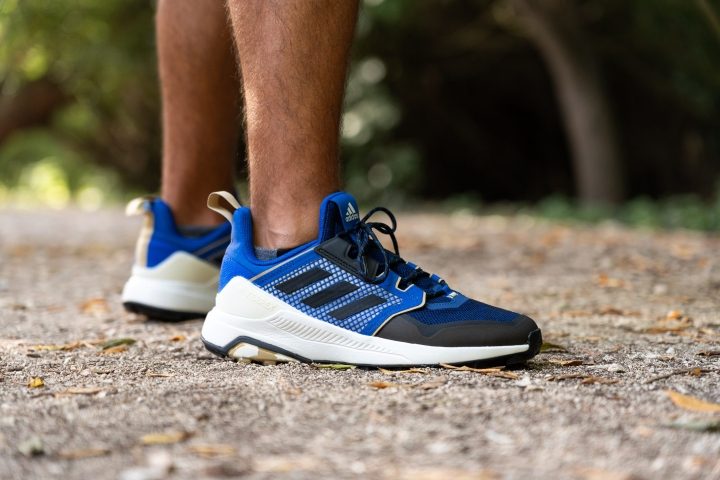
Hiking shoes for mud: deep, deeper, mud
Hiking on technical terrain, dealing with obstacles and debris on the trails, covering large muddy areas or even scrambling - you can’t do it all in the same shoe. At least not well.
Based on our wear tests, the deeper the lugs are, the better the hiking shoes perform in mud. What also plays a role here is the distance between the lugs. Too cramped and they collect the mud. Distanced from each other and we can’t believe how good the shoe is at shedding the mud.
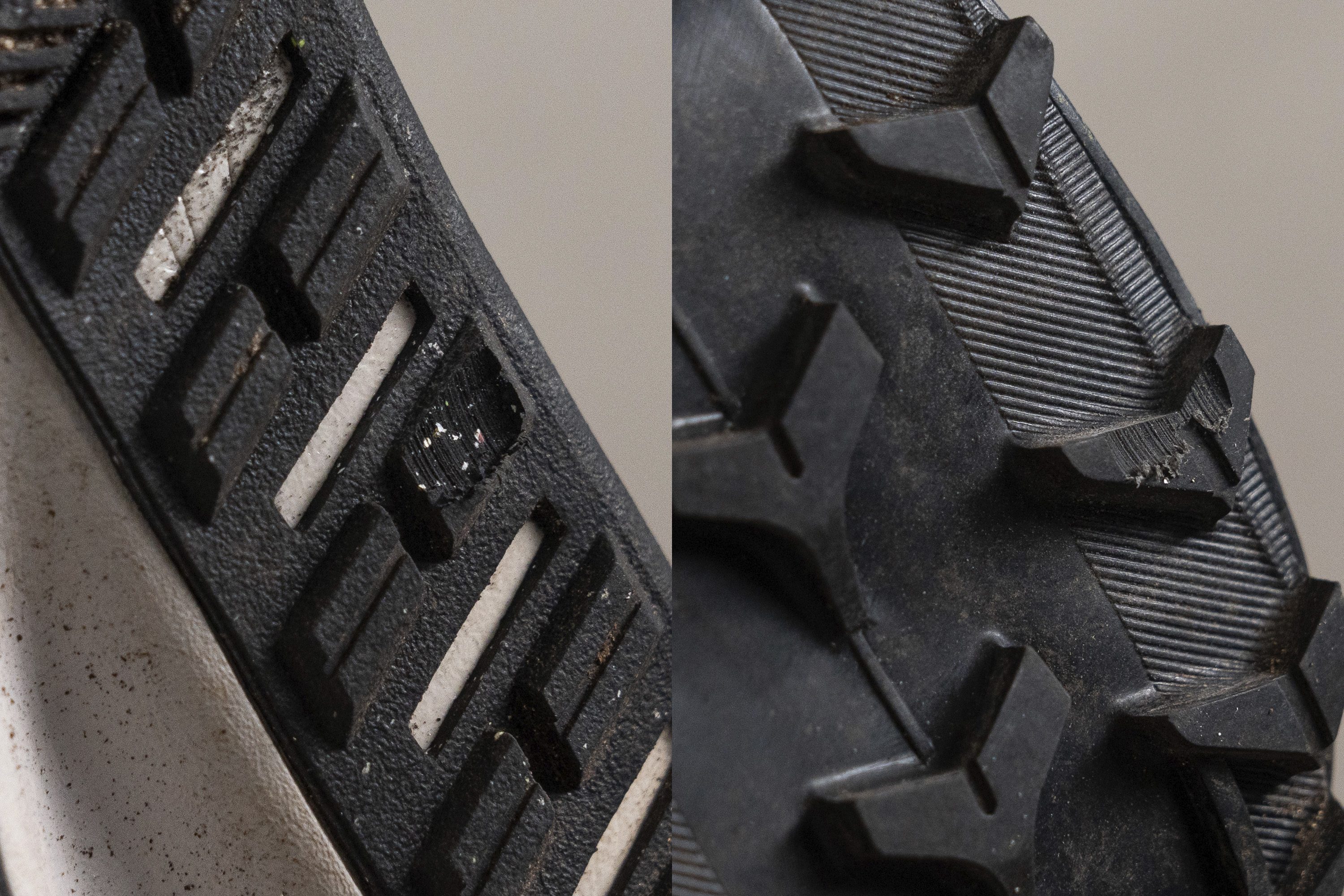
Our general guideline is: use hiking shoes with deep lugs (4 mm and deeper) for soft wet terrain like mud, slush, snow. Use around-the-average lugs (4 mm) with sticky rubber for more flat surfaces (like rock).

Not all rubber is the same and the sticker it is, the better. Keep in mind though: softer rubber wears down faster, especially when you use mud shoes on hard surfaces (like asphalt, concrete, rocks).
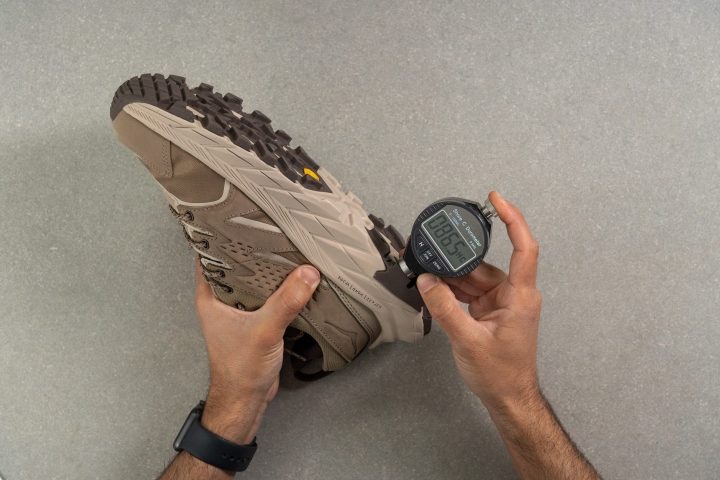
We use an HC shore durometer in our lab to measure the hardness of the rubber. Lower the number on a 1-100 scale, softer the rubber.
Hiking shoes for technical terrain: prioritising durability and stiffness
When hiking over rocky terrain, we advise going for firmer and stiffer shoes. Soft and flexible hiking shoes are great for nimbleness and softer (less dangerous) ground. Sharp rocks, especially a lot of them, ask for a firmer midsole - so that you don’t feel every little bump underneath your feet. And they ask for stiffness because stiff shoes feel more stable and safe (than flexible shoes) on such terrain.
We use a force gauge to band the shoe to 90 degrees and the more force we need to do that, the stiffer the shoe.
Our measurements of the midsole softness are as objective as possible: we cut all the shoes in half and poke them with a durometer.
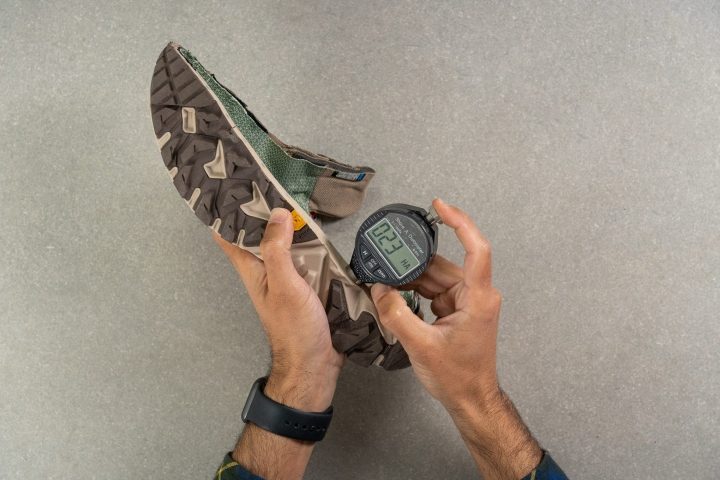
The HA durometer tells us how soft the midsole is. The higher the rating, the firmer the midsole.
If you’re planning to do a hike with a lot of obstacles, fallen trees and branches, and similar objects that can’t wait to poke your toes and destroy the shoes, we recommend looking for the most durable hiking shoes.
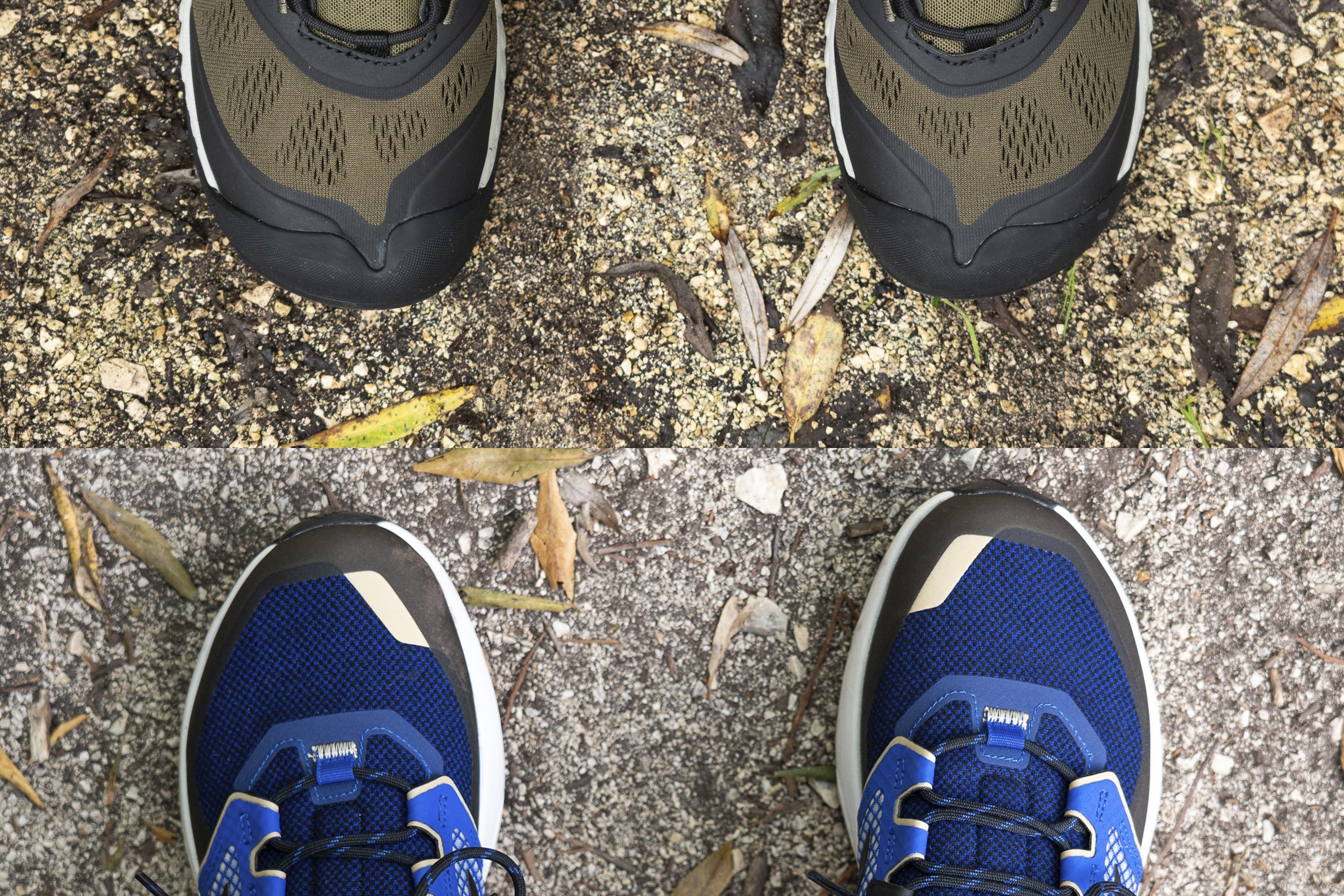
In the lab, we measure the durability of the upper and the outsole. We press the Dremel against both surfaces and examine how much damage there is. When it comes to the upper durability, we assign a rating of 1-5, where 1 is the least durable.
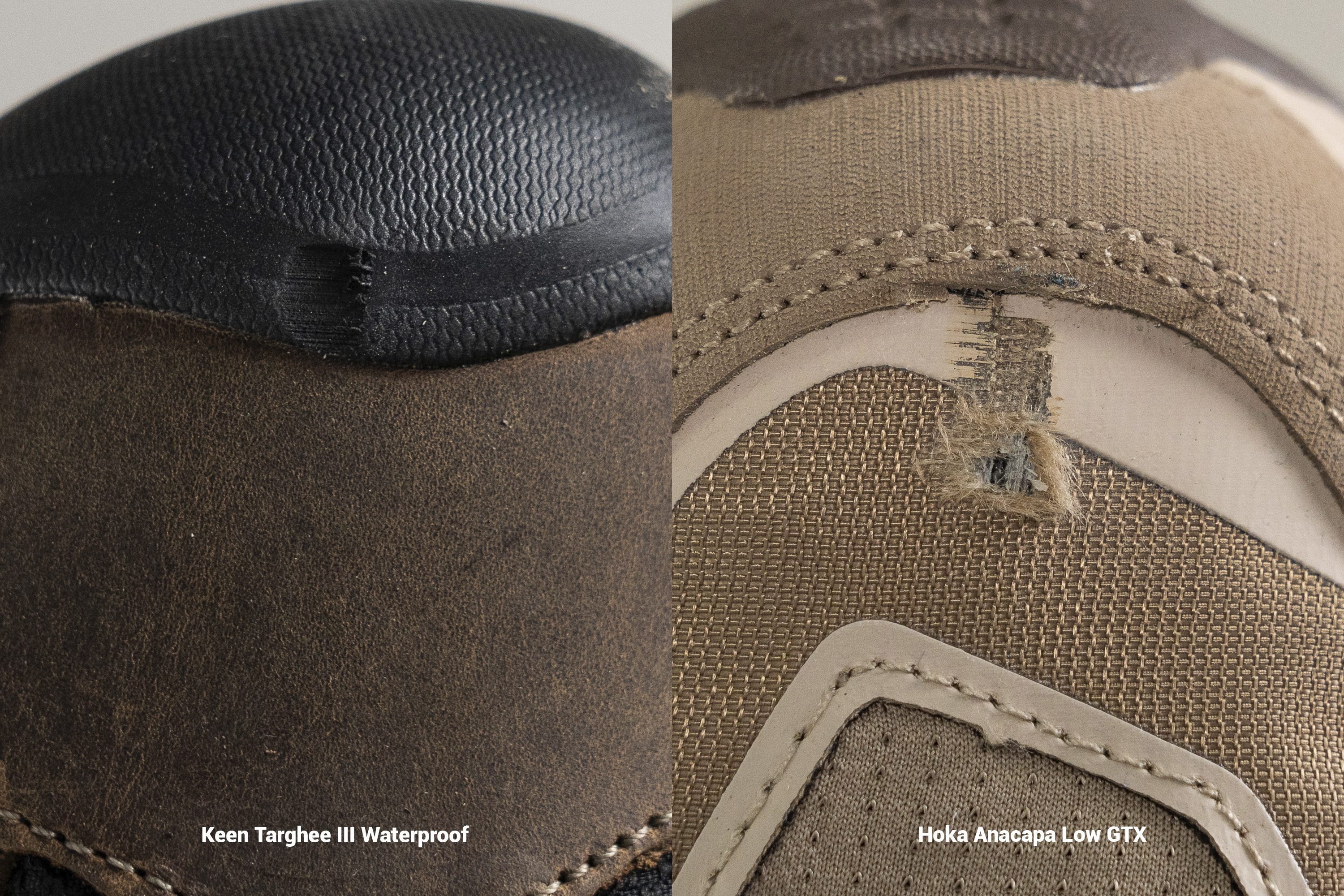
In the case of the outsole, we use a tyre tread depth gauge and check out the depth of the dent (in millimetres) our Dremel has made.
Less millimetres in the dent means more durability!
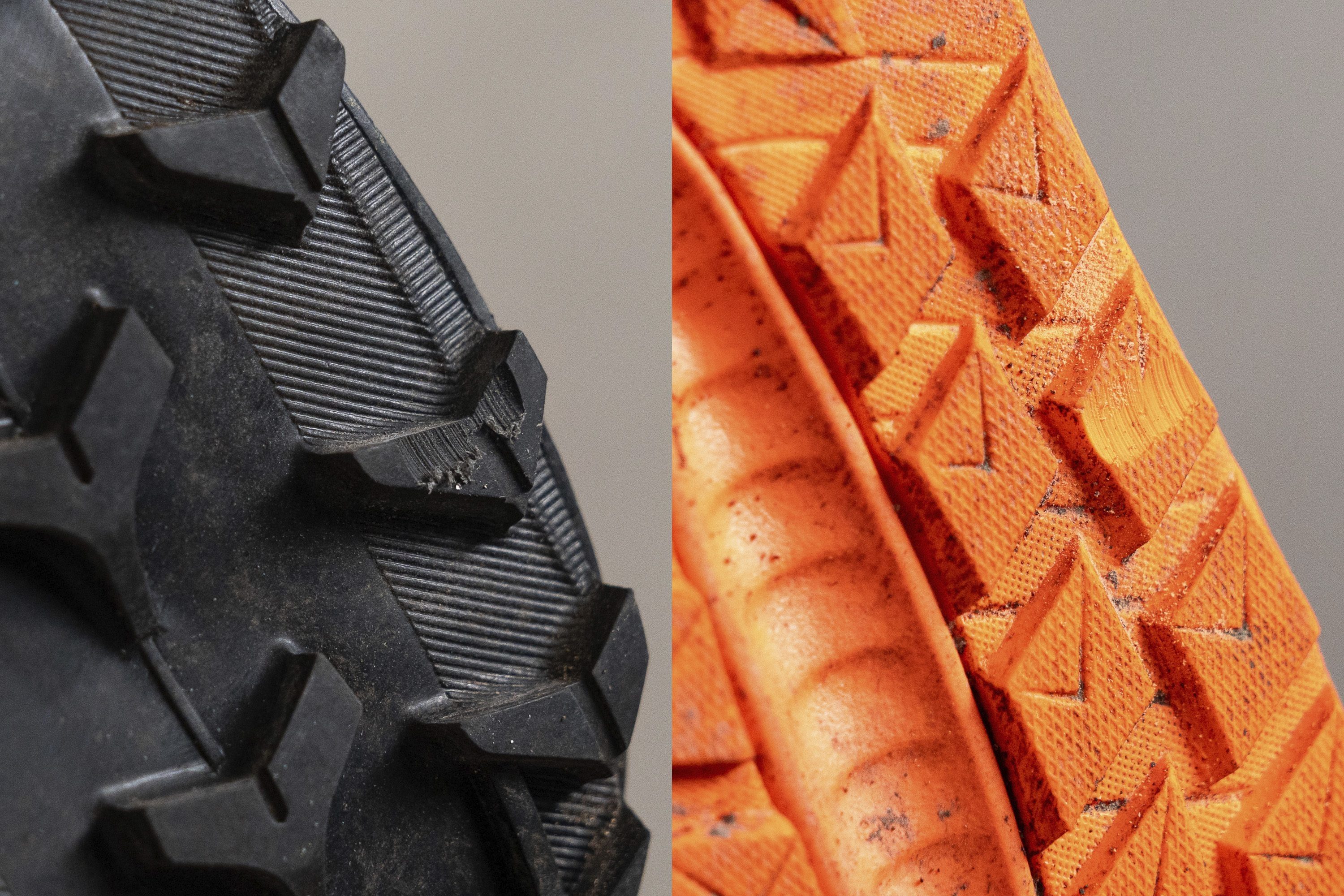
Based on all those tests, here are hiking shoes that score the highest in the durability department:
Carrying a heavy backpack: look for support in hiking shoes
If you’re packing light and bringing just the essentials, lightweight hikers will do. However, if you’re backpacking or simply need to carry a heavy load, we suggest you look for hiking shoes that
- offer lateral support (supportive features on the upper are present and give it more structure)
- are at least averagely cushioned (basically, skip minimalist hiking shoes)
- are on the firmer and stiffer end.
Cushioning, firmness and stiffness are always laid out in our reviews, along with the comparison to the average. On our wear tests, we assess the lateral stability of the shoe:
Support elements on the upper literally feel like they are locking the foot in place.
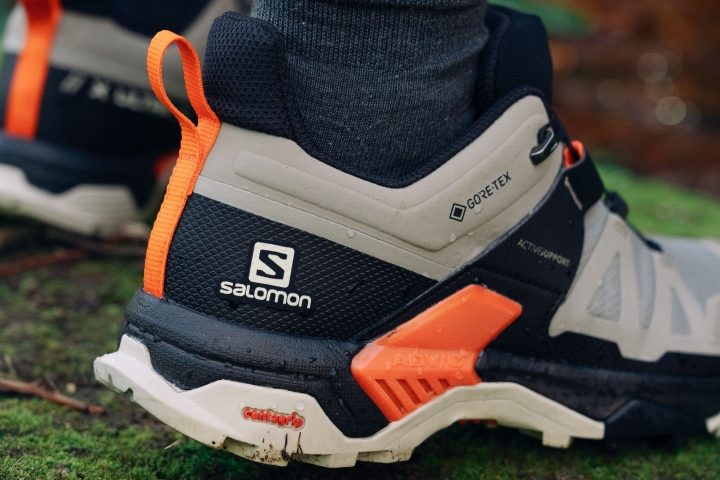
When it comes to cushioning, minimalist or barefoot hiking shoes are shoes we don't recommend. They don't have enough material between your feet and the ground and, therefore, not enough impact protection, any other protection, support or stability. See how flexible, wobbly and low-to-the-ground this minimalist V-trek hiking shoe is:
As discussed above in the technical-terrain section, hiking shoes that are too soft and flexible and almost running-shoe-like will make it difficult to walk with a heavy load.
Another thing we check in this department is the stiffness of the heel counter. Stiffer heel counters offer a better heel lockdown and, therefore, such shoes feel more stable. We rank it on a 1-5 scale, where 5 is the stiffest.
Most breathable hiking shoes: best for summer
When testing breathability, we don’t just wear the shoes in hot weather but also examine them in the lab. We pump the smoke into the shoes to see how much smoke will come out and where and, based on it, give the breathability rating 1-5, where 5 is the most breathable.
We also perform 2 more assessments: we check the upper above the flashlight and look at it under the microscope.
All these tests combined allow us to present the most breathable hiking shoes:
Hiking in rain and snow: look for waterproof hiking shoes
In order to keep your feet dry when hiking in wet weather, we recommend getting waterproof hiking shoes. The waterproof membrane most often used here is Gore-Tex or GTX. Snow hiking shoes are also waterproof but have deeper-than-avera lugs.
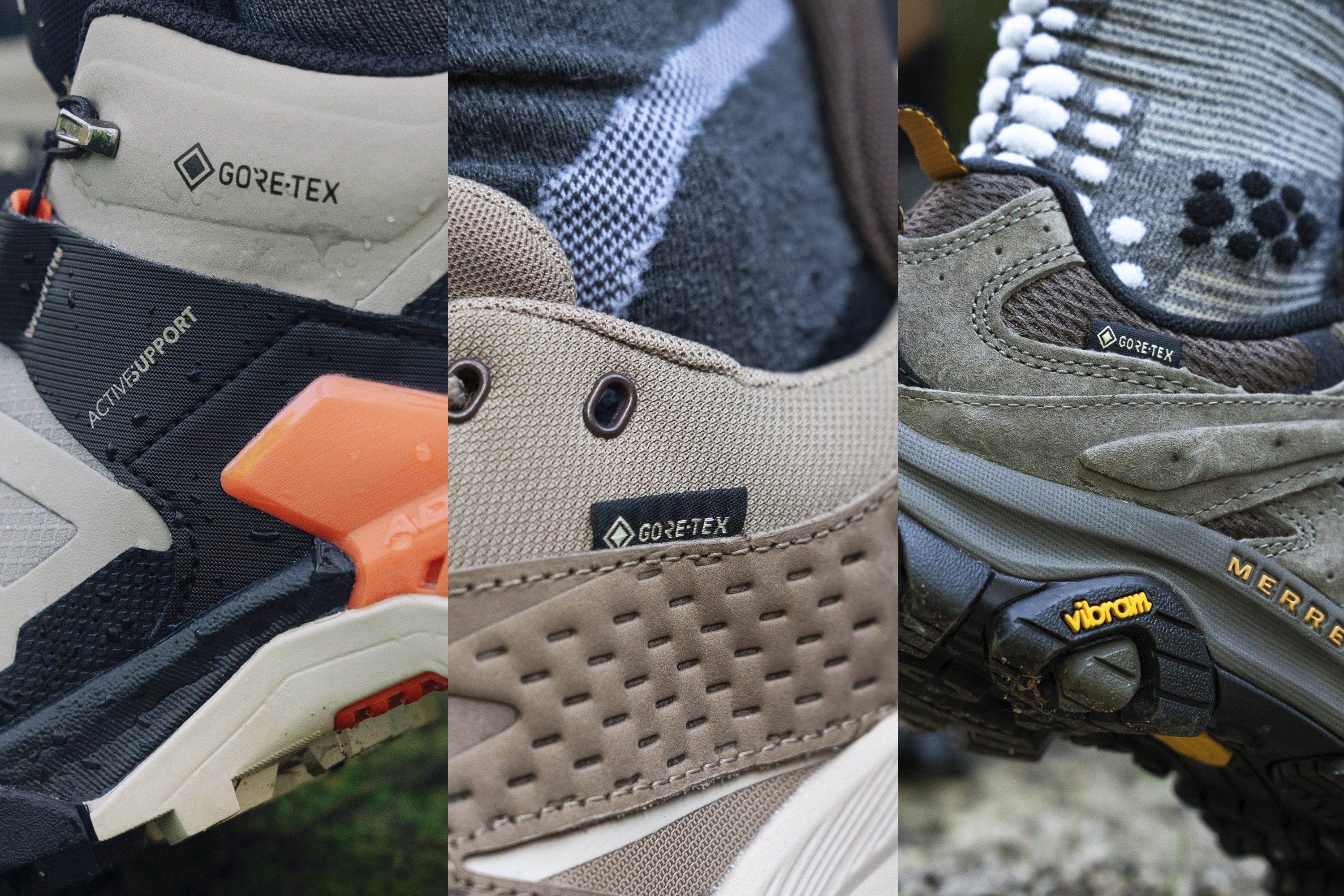
Waterproof hiking shoes usually have “Waterproof” or “GTX” in their name.
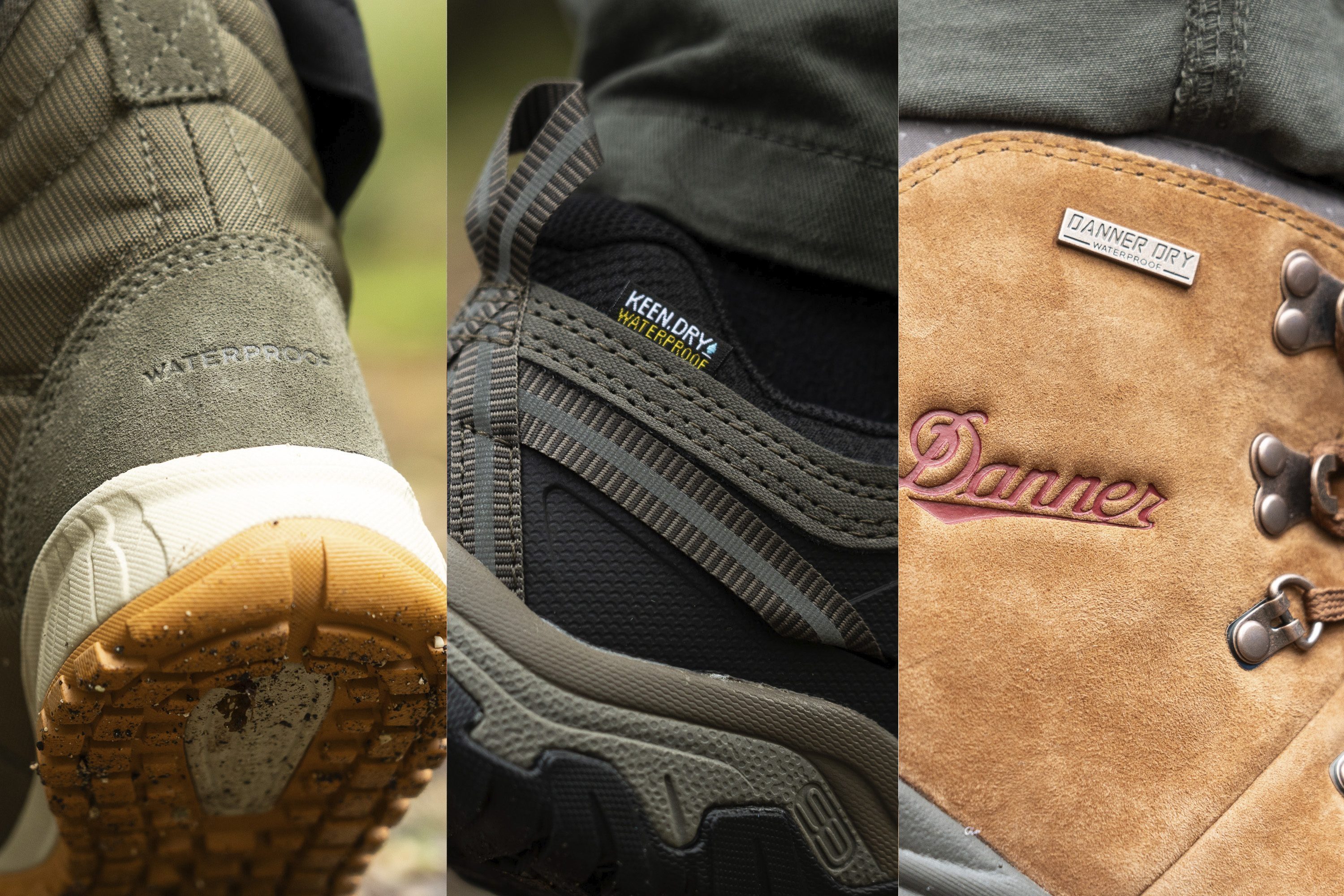
There 3 things to keep in mind when buying waterproof hiking shoes:
- They are not breathable. The membrane breathes a bit but usually it is average at its best.
- Water can still get inside your shoes by sliding down your legs or trousers or covering deep water levels.
- Once the water gets in, it is almost impossible to get it out due to the lack of breathability. Don’t expect the shoe to dry on its own together with your socks as you keep going. This could happen in non-Goretex trail running shoes that are very breathable, but not in waterproof hiking shoes.
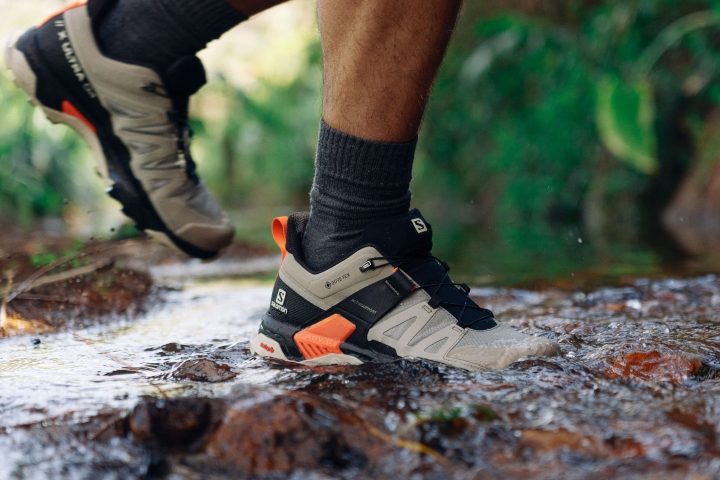
Learning the basics: Waterproof, water-resistant, and water-repellent materials
Labels like waterproof, water-repellent, and water-resistant often cause confusion. This overview offers clear guidance:
| Water-resistant | Water-repellent | Waterproof | |
| General characteristics | a tightly woven fabric that is naturally capable of resisting water upon contact | fabric treated with durable water-repellent (DWR) or hydrophobic chemicals | -fabric treated with DWR -have waterproofing membranes like Gore-Tex and OutDry -have seam-sealed construction for extra protection |
| Water protection level | low water protection | moderate water protection | high water protection |
| Water pressure resistance | 0-5000 mm (no pressure or moisture) | 6000-10000 mm (light pressure) | 10000-20000 mm (high to very high pressure) |
| Weather conditions best used in | light rain shower and dry snow | light rain and average snow | moderate to heavy rain and average to wet snow |
Hiking cold weather: hiking shoes best for winter
Not that these shoes should be waterproof but they should also behave well in cold weather.

We test this by measuring the flexibility and midsole softness at room temperature and after the shoe has spent 20 minutes in the freezer. We don’t want a shoe to feel like a brick at sub-zero temperatures!
Here are winter hiking shoes with the smallest difference in the 2 measurements:
Wide toebox in hiking shoes: measured in the lab
When looking for hiking shoes that fit wider forefeet, it’s easy to get lost in the reviews people leave because we all have different feet.
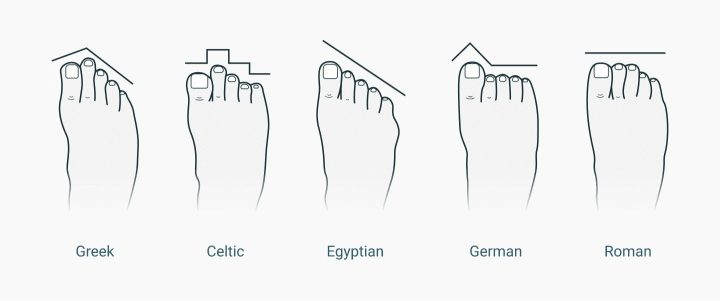
Because of that, our lab measurements are as objective as they get: we always use the same calliper to measure the width of the toebox. We do so 2 in places: where it’s widest and where the big toe is. And, we do it on the gel mould that perfectly fills the interior of the shoe!
Pouring the liquid gel into the hiking shoe and freezing it
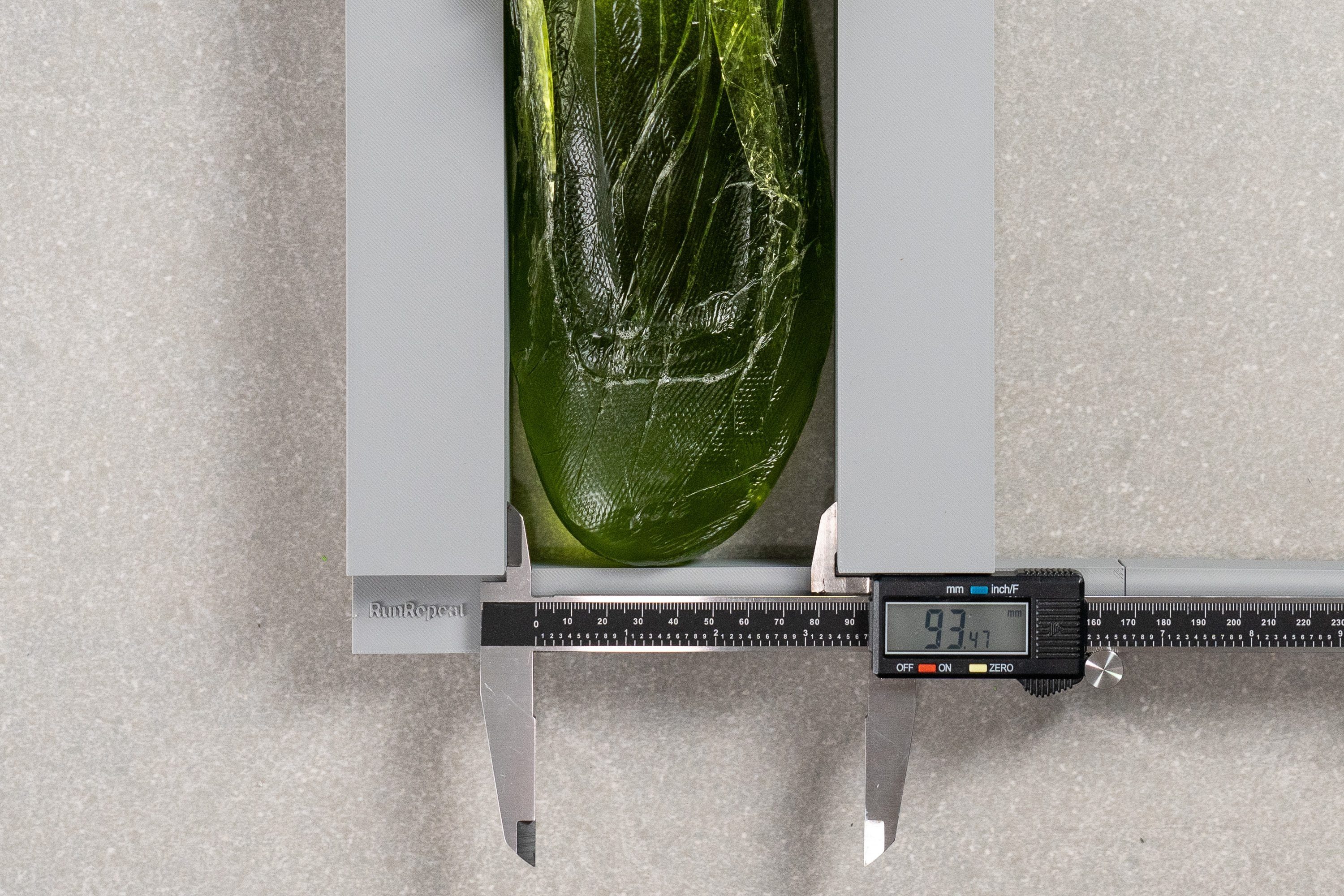
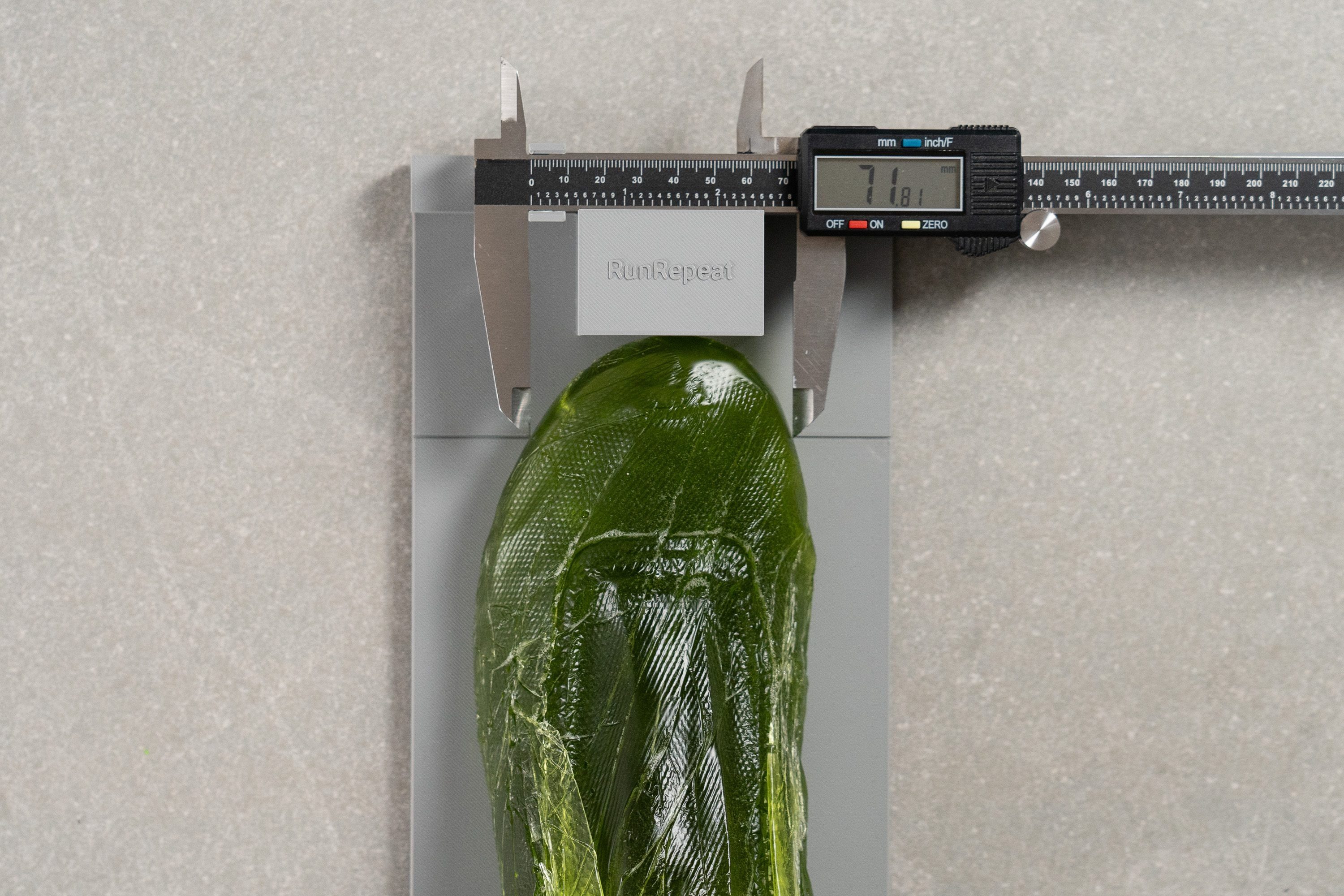
The width of the toebox at the big toe often has a bigger value for hikers with wider feet. With this knowledge, you’re equipped with a selection of hiking shoes that actually have wider toeboxes:
Keep in mind though that, just like with other footwear types, some upper materials are stretchy and offer more give. Others can be very stiff, and overlays on the toebox can keep your pinky toe in the strict position with no room to splay not even a little bit.
You may also be interested to know the height of the toebox, especially if you're prone to black toenails or bleeding toes. To avoid the pressure coming from the top, we suggest looking for toeboxes with more vertical space.
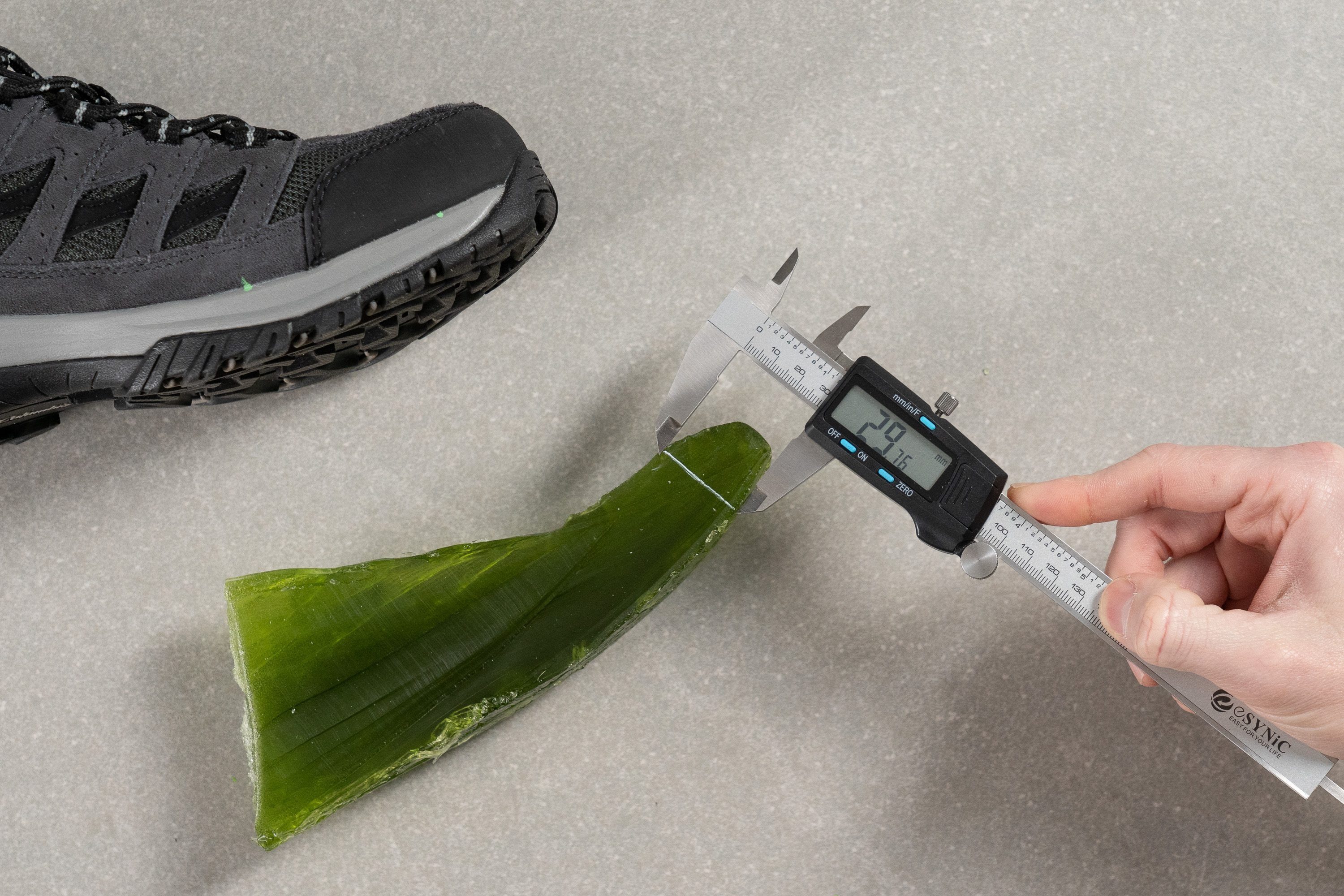
If focusing purely on the brand's labels, here's what to look for, depending on the gender:
|
Men |
Women |
|
|
Narrow |
B |
2A |
|
Medium/Standard |
D |
B |
|
Wide |
2E |
D |
|
Extra wide |
4E |
2E |
These labels are not the same because men's and women's feet are not the same, women tend to have narrower heels and wider forefoots.
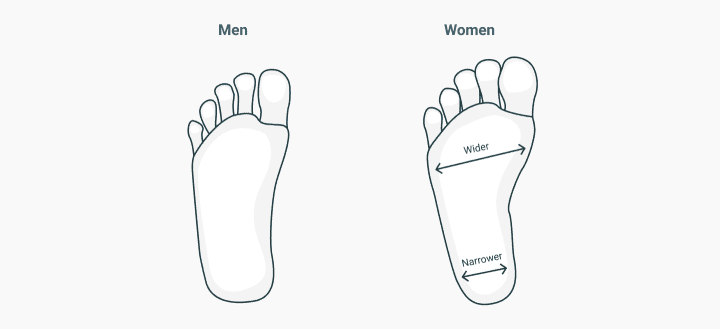
We wrote an in-depth guide on hiking shoes for wide feet in case you want to go into that direction.
6 steps for finding the perfect fit
Knowing your foot type makes a whole lot of difference. Aside from gauging if your feet are wide or narrow, if your feet have any special needs, make sure to treat them well.
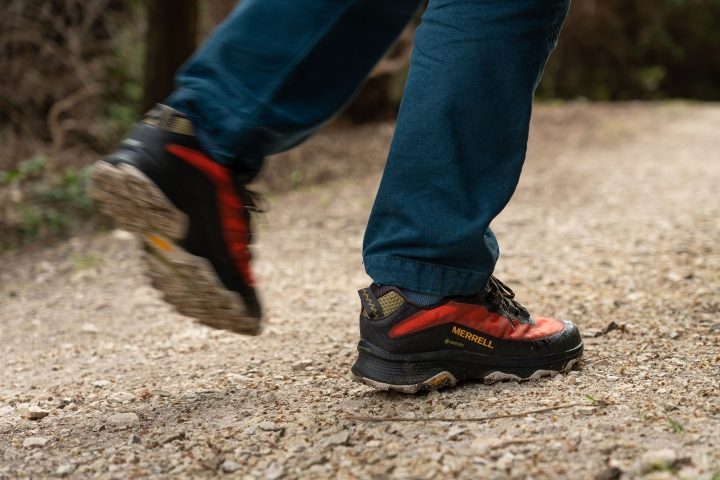
If you use orthotics, look for hiking shoes with a removable insole. Or, in case you are overpronating significantly or have plantar fasciitis, get the appropriate shoes that will not irritate your feet.
Here are the 6 steps to follow if you’re new to buying hiking shoes:
- Go shoe shopping in the afternoon. Expect your feet to swell after a day of activities. The same thing happens when hiking. So, it’s best to try on those new hikers late in the afternoon to get the best fit.
- Try it on, lace it up, and check for pressure points. There should be a thumb’s width space between your toes and the front of your shoes. If your feet move from side to side, then the hiking shoes are too wide. It should feel snug - comfortable and non-constricting.
- Make sure to try the shoes with your hiking socks on. Bring the socks that you plan to wear with your hikers when shoe shopping. Avoid using cotton since this type of fabric retains moisture and fails to provide insulation. Instead, choose wool or synthetic socks.
- Take your preferred insoles or orthotics with you. Default insoles often leave users disappointed. Aftermarket insoles or custom orthotics can greatly improve the fit of the shoe. If this fails, you can always try another pair from another brand.
- Use the ramp and walk up and down. This tests the shoe’s snugness. When you go up the board, observe for any heel lift. When you go down, check if your toes hit the front of the shoes. If your heel rises more than a quarter of an inch or if your toes hit the front, adjust the laces or try sizing up.
- Make sure to break in your shoes before your trip. Hiking shoes, especially the heavy, leather ones, require a different break-in time. Start small by wearing the shoes inside your house with your preferred socks. This might feel awkward but in the end, your feet will surely thank you). From there, increase your miles gradually.
Hiking shoe upper materials: mesh or leather?
We usually see hiking shoes with uppers made of synthetic mesh or leather.
Synthetic uppers are breathable, they dry quickly and weigh less. They also feel soft right out of the box.

The downside of having a mesh upper in hiking shoes is that they are less durable than the leather ones and they get soaked easily. Also, not a lot of support comes with the mesh uppers so we usually see them in shoes that are meant for (fast and) light hiking.
Leather (or suede, nubuck, full-grain) uppers are far more structured and supportive.
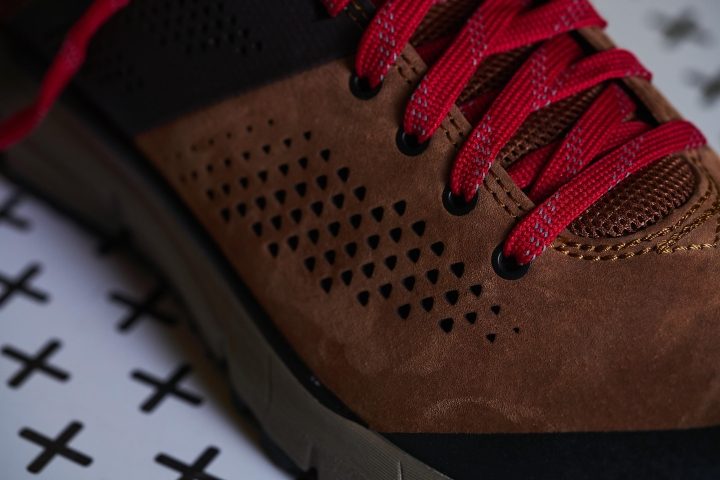
They are durable and warm. They even naturally repel water. However, they often ask for a break-in period and don’t breathe as well. Shoes with leather uppers weigh more.
Soft rubber or hard rubber outsoles: pros and cons
In our lab, after we’re done cutting the shoes in half, we measure the softness of the rubber with a Shore HC durometer. The lower the rating, the softer the rubber.
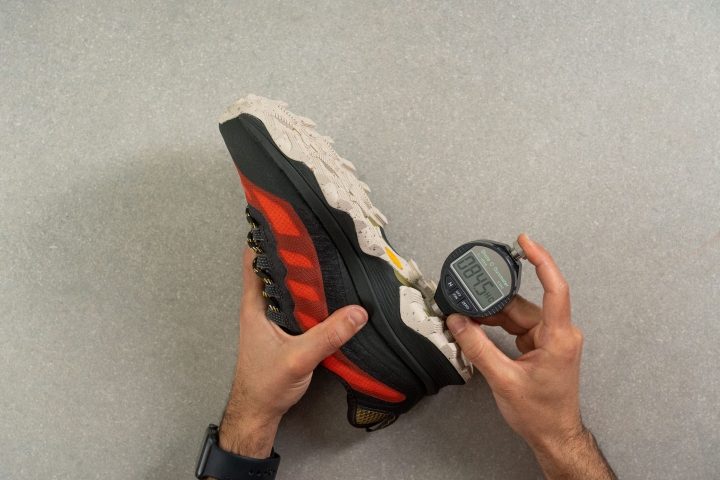
Softer rubber is better for deeper lugs and hiking in wet weather and on loose ground (like mud).
Softer rubber is more flexible and it’s stickier. Harder rubber, on the other hand, is more durable, stable and overall, more protective. However, it's not as flexible as the soft rubber. Harder rubber grips better on hard flatter surfaces, dry or wet. It offers more protection to our feet.
Get noticed in the dark
Some hiking shoes come with reflective elements. We love those as they make us more visible in low-visibility hikes and it’s easier to find shoes in a dark tent when all you have is a headlamp.
To check for these elements, we turn the light off in the lab and point the light at the shoes. See how great the KEEN Targhee III Waterproof looks in the dark!
 Hiring remote: Content writer / review specialist in
Hiring remote: Content writer / review specialist in 

